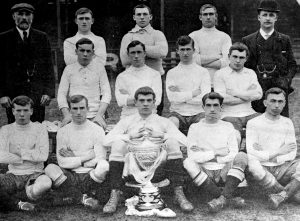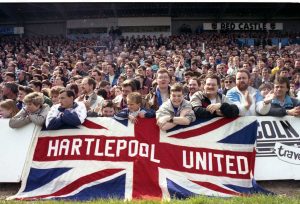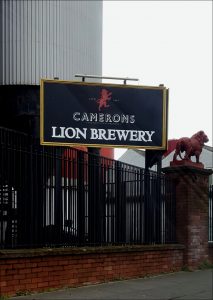Hartlepool United 2 Swindon Town 1
League 2
Saturday 1 April 2023

Pools news
The context
John and I often revisit grounds where we’ve enjoyed ourselves in the past. This was certainly true of Hartlepool – sadly, though, it also seemed as though they might not be playing League football for very much longer. The team had only been promoted two seasons ago following their 2017 relegation; today’s tricky fixture already looked vital to increasingly slim chances of staying up.
The history
I wrote a piece about Hartlepool United and the Victoria Ground back in 2020. Read it using this link .
Many small towns expanded rapidly when railways arrived during the nineteenth century. This proved especially true here, as coal traffic from County Durham mines helped develop the new port of West Hartlepool. This superseded old Hartlepool’s more northerly docks, largely isolating their two Headland station buildings (one dating from 1839 initially had waiting rooms and booking office in the hull of a grounded ship). Shuttle passenger services to West Hartlepool continued until 1947.
Expanding West Hartlepool offered trains serving more destinations. Several stations preceded today’s late-Victorian building on Church Street; two were sited at Mainsforth Terrace, another stood opposite the old Custom House in what’s now Hartlepool Marina. Headland’s second incarnation remained largely intact between Commercial Street and Bond Street. It later became a goods yard that – until Dr Beeching wielded his axe – retained platforms used by children traveling from nearby pit villages to Henry Smith School.
Victoria Park – then the Victoria Ground, named for Queen Victoria’s Diamond Jubilee – post-dates Hartlepool Station by only six years. West Hartlepool Rugby Club were its first owners, and when they folded in 1908 two football teams took over. Newly-formed Hartlepools United aspired to represent both old and new Hartlepool; Northern League side West Hartlepool Amateur dated from 1881, and had been Durham FA founder members.
West played in tasteful black and amber halves. Their original ground, Rosebank, occupied private land where Queensberry and Newlands Avenues are today. They soon went out of business themselves – not, however, before winning the 1905 FA Amateur Cup. Their itinerary en route to beating Clapton 3-2 at Shepherd’s Bush read like a North East almanac – Saltburn, Grangetown, Darlington St Augustine’s, Stockton, Bishop Auckland.
Hartlepool was first settled by 7th century monks. Modern history, however, owes everything to the Victorian port. Maritime significance has occasionally made this a dangerous place; the Victoria Ground’s location near West Hartlepool docks famously led to its main stand being destroyed by Zeppelins in 1916. German naval shells had also came uncomfortably close two years before, and surrounding areas would be bombed on 43 separate occasions during World War Two.
Reliance on shipping foreshadowed severe post-War decline. British Steel’s Greatham works closed in 1977, 10,000 jobs soon followed and local unemployment reached 30% during the Eighties. Pools’ fortunes also suffered. Their 1983-84 re-election application was a record fourteenth, three-figure crowds became commonplace and just 790 people turned up for the game against Stockport.
Against this backdrop the club’s subsequent revival appeared little short of miraculous. Promotion to Division Three in 1990-91 confirmed Cyril Knowles’ deserved reputation for energising apparently hopeless causes. Knowles’ managerial predecessors John Bird and Bob Moncur – despite being otherwise pretty average – had between them signed two strikers who contributed 49 goals towards it.
Joe Allon scored 35 of them. This earned the former Newcastle youngster – who arrived via Swansea – a big-money move to Chelsea in August 1991. He scored sporadically there, but (for whatever reason) couldn’t settle. Injuries blighted later spells with Brentford, Port Vale and Lincoln and would ultimately end his career. Four final years were spent back at Hartlepool, where eleven goals late on in their miserable 1996-97 campaign ultimately helped Mick Tait’s retain their League status.
Strike partner Paul Baker started at Southampton, played previously for Carlisle and scored 67 times over five seasons. He subsequently joined Motherwell, Gillingham, York, Torquay and Scunthorpe, eventually also returning to Hartlepool and becoming Tait’s player-coach. Scarborough then took him into non-League; another brief spell in League football followed with Carlisle, followed by successful spells managing Blyth, Newcastle Benfield and Newcastle Blue Star.
Knowles had started with Middlesbrough. Tottenham manager Bill Nicholson saw the nineteen-year-old left-back’s potential and signed him in 1964. He would become one of Spurs’ best-ever attacking defenders, winning FA Cup, League Cup and UEFA Cup medals; four England caps signified Terry Cooper’s consistency rather than his own significant talents. Retirement due to injury aged only 31 called premature time on more than four hundred top flight appearances.
The Hartlepool manager’s job – undoubtedly thankless – followed equally tough gigs at Darlington and Torquay. Knowles delivered unlikely success for both clubs, resigning when results eventually fell behind high self-imposed standards. With Hartlepool too he worked miracles, first comfortably avoiding relegation and then creating the side that would – due to his sudden illness and subsequent tragic death from a brain tumour – be promoted under coach Alan Murray.
The journey
Trans-Pennines driving feels far more enjoyable than going North-South. Today’s weather was damp and overcast; even so, my steady run though Brough via Kirkby Stephen and across the high ground to Bowes didn’t disappoint. I stopped off en route at the Stainmore Railway’s preserved station at Kirkby Stephen East. It hadn’t officially re-opened for summer, but two volunteers paused their tinkering with a locomotive and let me have a look around.
We left one car at Middleton Tyas. The village felt like a haven of calm despite being right next to Scotch Corner services. Rural types wandered about beneath umbrellas, sporting outdoor fashions and comparing dogs. From here it took just forty minutes to the Cameron’s brewery gates in downtown Hartlepool; early bird fans of both sides were parking up behind the Victoria Ground, struggling with broken ticket machines and ringing robotic 0800 numbers so they wouldn’t get fined.
The ground
Half of Victoria Park (as it’s now grandiosely known) screams mid-90s lower league functional. The Cyril Knowles Stand and adjacent terraced Town End nestle behind an artsy frontage that once appeared daring, hasn’t coped well with thirty years’ North Sea weather but does at least help everything look refreshingly lived-in. You can see Hartlepool’s heritage docks from here, along with the 19th century museum ship HMS Trincomalee.
‘Pools’ prefabricated 1960s Mill House stand now commemorates Neale Cooper, the ex-Aberdeen midfielder who was manager here between 2003-05 and 2011-12. His astute purchasing, productive youth policy and exciting football reached an apogee with the 2005 play-off final against Sheffield Wednesday. Cooper had been controversially sacked with one game remaining; 4-2 extra time defeat saw his team agonisingly close to second tier football.
Many football ground structures – like Zoo Corner at Plymouth, and Watford’s Rookery – recall forgotten landmarks. The Rink End does too. Queen’s Rink Ballroom was Hartlepool’s social hub for sixty years; generations of local romances, marriages and odds-defeating good times happened here. Now its memory chiefly survives thanks to a distinctly underwhelming Taylor Report terrace conversion. That’s irony for you.
Flesh and wine
First stop the Mill House. This is one of those admirable turnstile-facing pubs, sadly rare nowadays; Cameron’s ale, friendly barmaids, noisy punters and PNE v Blackpool on TV provided perfect pre-match ambience. We then had a bonus pint in the equally friendly Supporters’ Association bar, which – as ever – offered walls lined with memorabilia and the sort of pessimistic yet happy-go-lucky atmosphere only time-served fans can create.
A small pork pie from the Middleton Tyas village shop had proved resiliently stomach-lining. Now I was ready for more substantial rations. As at Stockport we had unwittingly bought tickets for the family stand; here, though, people seemed far more tolerant. No-one was particularly bothered when two beered-up arlarses arrived bang on kick-off, dropping crumbs (or in John’s case, burger onions) all over their rucksacks, packed lunches and other assorted paraphernalia.
The game
Two points stood between Hartlepool and safety. Third-from-bottom Crawley Town would visit here a fortnight from now; things were definitely salvageable, but any recovery needed to start soon. Cue the worst possible start as Rushian Hepburn-Murphy’s speculative effort put Swindon ahead. Home goalkeeper Jakub Stolarczyk could only dive despairingly and wonder just why footballers have such posh names nowadays.
Hartlepool grew stronger as time went on. Connor Jennings was playing well; he headed against the bar and then – after Jamie Sterry had forced a good save from Sol Brynn – equalised by turning in Wes McDonald’s low cross. That seemed to be that, but cometh the hour etc etc. Sub Oliver Finney’s fresh legs helped unnerve the retreating Swindon defence, his brisk 20-yarder evaded Brynn and four thousand Poolies went home much, much happier.
Teams and goals
Hartlepool: Stolarczyk, Sterry, Dodds, Murray (McDonald 63), Pruti, Ferguson, Kemp (Crawford 85), Cooke (Finney 86), Sylla, Umerah (Hamilton 62), Jennings. Unused subs: Killip, Featherstone, Foran.
Swindon: Brynn, Hutton, Brewitt, Blake-Tracy, Tomlinson, Khan, McEachran, Williams (Kadji 74), Shade, Austin (Adeloye 80), Hepburn-Murphy. Unused subs: Clayton, Jephcott, Cain, Lavinier, Copland.
Goals: Hartlepool: Jennings 88, Finney 94. Swindon: Hepburn-Murphy 4.
Attendance 4815.





















